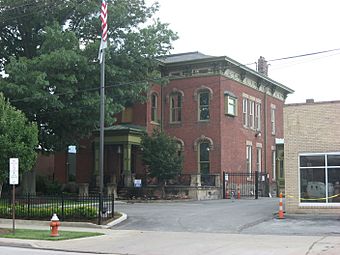Southworth House (Cleveland, Ohio) facts for kids
Quick facts for kids |
|
|
Southworth House
|
|

Street view of the Southworth House
|
|
| Location | 3334 Prospect Ave., Cleveland, Ohio, United States |
|---|---|
| Area | less than one acre |
| Built | 1879 |
| Architectural style | Neoclassical, Italianate |
| MPS | Upper Prospect MRA |
| NRHP reference No. | 84000234 |
| Added to NRHP | November 1, 1984 |
The Southworth House is a cool old building in Cleveland, Ohio, United States. It was built way back in 1879. It mixes two styles of building design: Classical Revival and Italianate. The house is named after its first owner, W.P. Southworth, who was an important person in Cleveland a long time ago. For many years, the house has been used for different businesses. It's one of many historic spots in its neighborhood and has been on the National Register of Historic Places since 1984.
Building the Southworth House
The Southworth House was built in 1879 by William Palmer Southworth. He was a businessman in Cleveland who started a big grocery store called W.P. Southworth Co. in the 1850s. William and his wife, Louise, were well-known in Cleveland. Louise was a leader in the women's suffrage movement, which worked for women's right to vote. William's store was so important that when it burned down in 1882, it was even reported on the front page of The New York Times.
The house stands on a strong stone foundation with a basement. Its walls are made of brick. We don't know the name of the person who designed the house. It has three floors and nineteen rooms. By 1904, Mr. Southworth had an elevator installed, and it's still there today!
Who Lived in the House After Southworth?
In 1906, a group of Baptists in Cleveland started an organization to create a retirement home for older Baptists. About ten months later, Mr. Southworth sold his house to them. A very rich and famous businessman named John D. Rockefeller, who was also a Baptist, helped pay for it.
With help from local churches, the retirement home opened on October 16, 1907. By 1910, the home was helping fourteen people. The Southworth House didn't stay a retirement home for long. The Baptist Home moved to a new place in 1919 and sold the house that same year. Since then, the house has been used for many different things.
During the 1950s and 1960s, various businesses had offices in the house. It was sometimes called the "Edelmar Building" or the "Accountants Building." In 1973, a fraternity from nearby Cleveland State University bought the house. It later became the fraternity house for the Delta Sigma Phi group.
The house has had several owners since its fraternity days. In 1997, a health care company bought it. Later, a company that works to save old buildings bought it at an auction. Today, the Southworth House is used for offices by different groups, including a health care company and a local branch of the Laborers' International Union of North America.
Saving a Historic Building
The Southworth House is special because it's recognized as an important landmark both in Cleveland and across the country. On November 1, 1984, it was added to the National Register of Historic Places. This means it's a building with historical importance that should be protected. It was added because of its unique mix of Classical Revival and Italianate architecture styles, and because of its connection to William Palmer Southworth.
The city of Cleveland has also named the Southworth House a Cleveland Landmark. Since 1984, people have worked hard to preserve the house. In 1996, the Cleveland City Council gave over $250,000 to help buy and fix up the property. Architects Scott and Analia Dimit started restoring the house. When the Laborers Union Local 860 bought it in 2005, they continued the restoration work. The construction workers made it their union hall and finished the repairs in October 2007. In 2009, the National Trust for Historic Preservation gave an award for the great restoration work. Today, the house has beautiful wrought iron details and a unique Italianate front.




